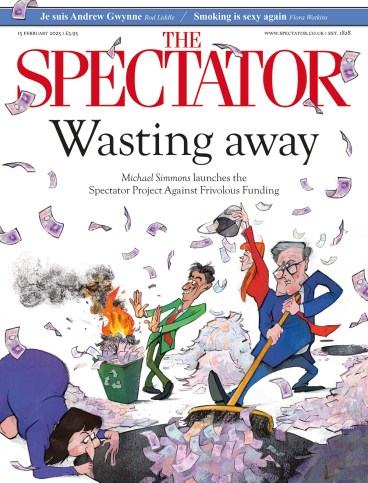
A few weeks ago, a couple of men with ladders started work on a former bridal boutique at the end of my road. I’ve no idea how old the building is. Its pitched roof and intricate gable and the sort of pattern brickwork no one seems to bother with these days suggest it’s Victorian, but it could be older. Beneath the first-floor windows was a decorative cornice. Under that, between a pair of attractive corbels, was a slim wooden fascia upon which the name of the shop was painted in stencilled letters. The chaps with the ladders got rid of all that. They ripped out the timber and chucked it in a skip. The building houses an estate agent now – a flat aluminium fascia, double the size of the old one, informs you of the fact.
Much has been written about the uglification of our towns and cities, not least by Sean Thomas in a depressingly on-the-nail article for The Spectator’s website last summer. We talk about hideous high-rises and miserable new-builds; about domineering road signs and peeling billboards; about smashed telephone boxes and plastic bus stops; about litter and graffiti and what to do with all the wheelie bins. I’d like to talk about shopfronts.
It’s difficult to pinpoint when, exactly, our high streets went from parades of pleasingly styled shops – with awnings and arcade widows and decoratively tiled doorways – to rows of cheaply made, puerilely designed signs. How did we go from the Shambles to Sparkhill’s Stratford Road? (Google it.)
The rise of the kebab house and fried chicken shop in the mid-1990s didn’t help. (Interestingly, during research for her 2009 book, Chicken: Low Art, High Calorie, Siâron Hughes discovered that some 90 per cent of London’s chicken shop signage was the work of one company, M.B.C. Signs in Leyton.) Nor did the more recent boom of ‘Turkish’ barbershops (mostly run by Albanians, Romanians and Kurds, it seems), suspiciously prolific bureaux de change and lit-up-like-a-Christmas-tree international food stores.
And yet to scapegoat immigrant businesses for the aesthetic decline of our high streets is to ignore the fact that some of the worst offenders are nationwide companies. Culprits include One Stop (owned by Tesco), McColl’s (owned by Morrisons), the Post Office (mostly franchised since its split from Royal Mail in 2012), Poundland (and its various discount-store rivals), Sports Direct, Shoezone, The Works, plus Coral, Ladbrokes and every other bookmaker in pursuit of leases in the most impoverished neighbourhoods they can find. Props to Costcutter, KFC, even McDonald’s, which all seem to have realised that a pleasant shopfront might actually attract people inside.
I’m lucky. The town in which I live is a designated conservation area, so properties are subject to tighter planning controls. The council can reject designs and materials that are out of character, or which fail to contribute to a sense of place. At least, that’s the theory.
Picking an attractive typeface, opting for low-key colours – all that costs nothing
In 2022, Canterbury council was forced to earmark £200,000 towards lawyers and enforcement officers to combat the blight of garish shopfronts. Since then, the city has issued 22 notices to businesses in listed buildings that had made alterations without permission. Since 2021, other councils that have had to allocate funds for removing, or improving, unsuitable shopfronts include: Bath and North East Somerset, Bradford, Central Bedfordshire, Kirklees (Huddersfield), Knowsley (Merseyside), Lincoln, Mid Suffolk, North Somerset, Nottingham, Tonbridge and Malling, West Dunbartonshire, and West Lothian.
Mid Suffolk had to fork out £400,000 to sort out Stowmarket alone; it’s costing Knowsley £1.75 million to tidy up one town (Huyton); and a property company in Huddersfield has applied for a £610,500 grant from the council to replace just one row of metal-fronted shops. All this when one in four councils in England is one equal-pay lawsuit away from bankruptcy. The National Lottery Heritage Fund and Historic England are helping out where they can: the former has pledged £682,400 to rectify Nottingham’s Carrington Street; the latter is funding a £1.68 million restoration of shopfronts in Lincoln. How did things get so bad? And do we care?
We should. Not least because there’s absolutely no reason our shopfronts should be in such an awful state. It’s money, goes the argument: no one’s got any. It’s far cheaper to box over in plastic what’s already there rather than sand down and repaint. Perhaps. Mostly, though, it’s a question of taste. And that’s the depressing thing. Because picking an attractive typeface, opting for low-key colours, working out what’s an appropriate-sized fascia – all that costs nothing. That’s judgment; respect for what’s being replaced, for what else is around.
What’s the answer? In 2010, the government launched a nationwide anti-littering campaign called ‘Love Where You Live’. Judge for yourself its success, but at least the sentiment was there. Our shopfronts might benefit from a similar self-improvement scheme. But what hope do we have when one of the first things the new government did was tell developers they need no longer worry about making buildings attractive?
Yet among the giant vinyl window stickers and brash, overblown signs, there are occasional glimmers of beauty. Until recently, I worked out of an office in Queensway, a neighbourhood in Bayswater not traditionally known as a hotbed of aesthetic aspiration. But there, sandwiched between the vape shops and pound shops and shops that somehow survive by selling mobile phone cases and cardboard masks of the royal family, was a fried chicken shop: Filthy Feathers.
It had a wooden fascia, painted in tasteful taupe, upon which the letters were stencilled in a neat serif font. Above was an elegant cornice; below, an awning. The shop’s timber stallrisers and window frames were painted to match the fascia. It was the best-looking shop on the street. It made you want to go inside. Which, we seem to have forgotten, is the whole point of a shopfront in the first place.






Comments